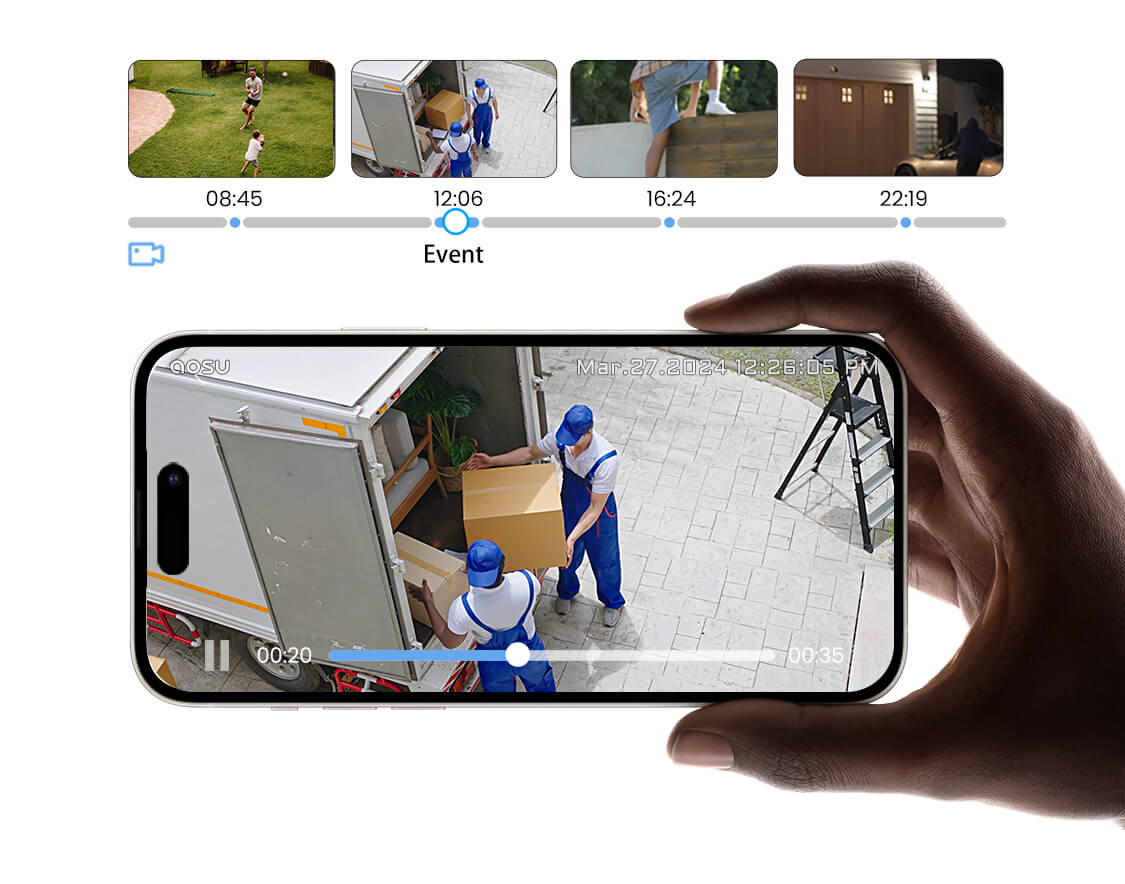In today's increasingly connected world, the threat of Wi-Fi jamming is a growing concern. Defending against Wi-Fi jammers is crucial for ensuring the security and reliability of your wireless network. Whether at home or in a business setting, Wi-Fi jammers can disrupt connections, causing frustration and potentially leaving your devices vulnerable. These devices are designed to block or interfere with Wi-Fi signals, leading to loss of connectivity for anything from computers to smart home devices, including critical security systems.
Fortunately, there are steps you can take to protect your network from these attacks. From using dual-band routers and securing your network with strong encryption to installing local storage-enabled security cameras, such as aosu cameras, you can minimize the impact of interference. Understanding the signs of jamming and implementing proactive measures will help safeguard your home or business against disruptions, ensuring continuous connectivity and the uninterrupted operation of your devices. In this guide, we'll explore practical and effective tips for defending against Wi-Fi jammers and securing your wireless network from interference.
What Is Wi-Fi Jamming?
Wi-Fi jamming refers to the intentional disruption of wireless signals by using devices known as Wi-Fi jammers. These devices are designed to interfere with the communication between your router and connected devices, causing network outages or slowdowns. Defending against Wi-Fi jammers is crucial because these disruptions can lead to unprotected smart devices, loss of security footage, and general network instability. There are three types of Wi-Fi jammers, each working in different ways to disrupt your wireless network:
- Signal Jammers
- Frequency-Specific Jammers
- Mobile Jammers
Signal Jammers emit strong signals on the same frequency as your Wi-Fi, effectively drowning out your router’s signal and making it impossible for your devices to maintain a connection. Frequency-Specific Jammers target specific frequencies, such as 2.4 GHz or 5 GHz bands, causing interference in those frequency ranges while leaving others unaffected. Mobile Jammers often portable, they can be used to disrupt Wi-Fi signals in a localized area, making them particularly dangerous in public spaces or high-traffic areas.Understanding these types of Wi-Fi jammers can help you better defend your network and ensure continuous, reliable connectivity.
Why Is Your Wi-Fi Jammed?
Wi-Fi jamming can happen for various reasons, from accidental interference to intentional disruptions. Defending against Wi-Fi jammers begins with recognizing the potential causes. Understanding why your network is being jammed is the first step in addressing the issue effectively. Below are some common reasons why your Wi-Fi might experience jamming:
- Interference from Other Devices
- Crowded Wi-Fi Channels
- Intentional Jamming
- Neighbor’s Powerful Wi-Fi Router
- Denial-of-Service (DoS) Attacks
Wi-Fi jamming can occur for several reasons, both intentional and unintentional. Everyday devices like microwaves, baby monitors, and cordless phones often operate on the 2.4 GHz frequency, which can interfere with your Wi-Fi signal and cause disruptions similar to jamming. Additionally, crowded Wi-Fi channels, especially in densely populated areas like apartment complexes, can lead to overlapping signals that slow down or disrupt your connection. Intentional jamming, where someone deliberately uses a jammer to flood the frequency with noise, is another serious threat that can render your network unusable. Neighboring Wi-Fi routers with high power can also overwhelm your signal if they operate on the same channel, leading to connection issues. Lastly, Denial-of-Service (DoS) attacks, where an attacker floods your network with traffic, can cause your devices to lose connectivity. Defending against Wi-Fi jammers and understanding these causes can help maintain a reliable network and prevent disruptions.

Signs That Your Wi-Fi Might Be Jammed
Wi-Fi jamming can be both frustrating and disruptive, leading to noticeable drops in your network’s performance. Recognizing the signs early is key to defending against Wi-Fi jammers and securing your connection. If your Wi-Fi is being jammed, you may notice the following issues affecting your network.
Sudden and Frequent Connection Drops
A clear sign of Wi-Fi jamming is when your devices lose connection to the network unexpectedly and repeatedly. If your Wi-Fi signal drops often without a clear cause, jamming could be the culprit.
Drastically Reduced Internet Speeds
Wi-Fi jammers can cause a significant slowdown in your internet speed. Even if you have a strong signal, web pages, apps, and video streams may take unusually long to load, creating a frustrating experience.
Inability to Connect to Wi-Fi
If you suddenly cannot connect any of your devices to the Wi-Fi network, even though the router appears to be working, it may be a sign of jamming. In more severe cases, jamming can block all devices from accessing the network.
Unusual Network Behavior
You might notice strange network behavior, like devices showing a strong Wi-Fi signal but being unable to access the internet. This mismatch between signal strength and performance is a common indicator of Wi-Fi interference or jamming.
Multiple Devices Affected
Jamming impacts the entire network, not just one device. If all of your connected devices—such as smartphones, laptops, or tablets—experience connectivity issues at the same time, it’s likely your network is being jammed.
Security Devices Stop Working
One critical result of Wi-Fi jamming is the failure of security devices, like cameras, alarms, or smart locks, which rely on Wi-Fi. If your security system stops sending alerts or recording footage, jamming could be disrupting its connection. This is where using aosu security cameras with local storage can be crucial, as they continue recording even during Wi-Fi outages.
How to Prevent Wi-Fi Jamming
Preventing Wi-Fi jamming requires a combination of proactive measures to protect your wireless network and ensure your security devices remain functional. Here are some effective strategies to defend against Wi-Fi jammers:
1. Use Dual-Band Security Cameras
Jammers often target the 2.4 GHz frequency, which many Wi-Fi devices use. Choosing dual-band security cameras, like aosu cameras, allows your devices to switch to the 5 GHz band if the 2.4 GHz band is being jammed. This ensures continuous monitoring even during interference.
2. Real-Time Alerts
Invest in security cameras that offer real-time alerts. aosu cameras, for example, notify you immediately if they detect interference or unusual activity. This allows you to take action quickly, even if your Wi-Fi is compromised.
3. Wired Connections for Security
One of the most reliable ways to avoid Wi-Fi jamming is by using wired connections for critical devices. Connecting your security cameras via Ethernet ensures they remain functional, even if the Wi-Fi network is disrupted by jammers.
4. Local Storage on Security Cameras
When your Wi-Fi is jammed, you might lose access to cloud storage for your security footage. Using cameras with local storage options, like aosu security cameras, ensures that video recordings are stored directly on the device. This way, you still have access to important footage, even during a network outage.
5. Advanced Encryption and Protection
Use Wi-Fi devices with advanced encryption protocols, such as WPA3. This encryption makes it harder for intruders to jam your network or interfere with your devices. Ensuring your network is password-protected with strong encryption reduces the risk of jamming and unauthorized access.
6. Legal Action and Reporting
Wi-Fi jamming is illegal in many regions. If you suspect your network is being deliberately jammed, you can report the activity to local authorities or the Federal Communications Commission (FCC) in the U.S. Legal action may help deter malicious actors from disrupting your network.
Protect Your Home with aosu
aosu security cameras are designed to provide comprehensive protection for your home with advanced features that ensure reliable monitoring. These cameras offer high-definition video quality, delivering clear and detailed footage, whether it's day or night, and come equipped with wide-angle lenses and infrared night vision for full coverage in any lighting condition. aosu cameras support dual-band Wi-Fi (2.4 GHz and 5 GHz), ensuring a stable connection even in challenging environments. In the event of network issues or Wi-Fi jamming, the cameras' local storage feature guarantees continuous recording, so you never miss crucial moments. With real-time alerts, you’ll receive instant notifications on your smartphone when motion is detected, keeping you informed no matter where you are. Additionally, two-way audio allows you to communicate directly with visitors or deter potential intruders. Built to withstand harsh weather, aosu cameras offer a durable, weatherproof design, making them ideal for both indoor and outdoor use.

Conclusion
In conclusion, defending against Wi-Fi jammers is crucial to maintaining a secure and reliable wireless network. By implementing strategies such as using dual-band routers, enabling local storage on security cameras, and securing your network with strong encryption, you can minimize the risk of jamming and ensure continuous connectivity. For added protection, consider incorporating wired connections for critical devices and investing in security systems that offer real-time alerts and fallback mechanisms like aosu cameras. These measures will help safeguard your home or business from interference, allowing your network to function smoothly and securely despite potential threats.










Leave a comment
This site is protected by hCaptcha and the hCaptcha Privacy Policy and Terms of Service apply.